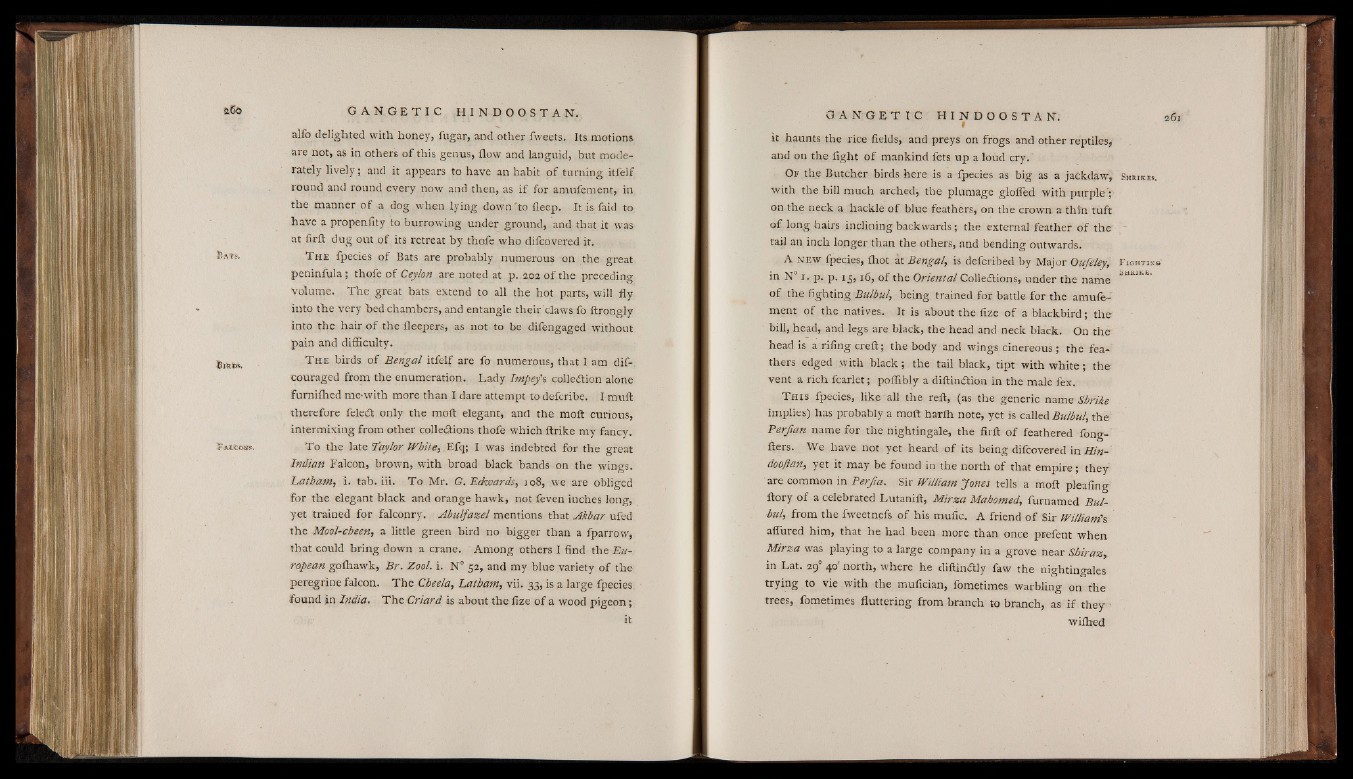
alfo delighted with honey, fugar, and other fweets. Its motions
are not, as in other's of this genus, flow and languid, but moderately
lively ; and it appears to have an habit of turning itfelf
round and round every now and then, as i f for amufement, in
the manner of a dog when lying down'to fleep. It is faid~ to
have a propenfity to burrowing under ground, and that it was
at firft dug out of its retreat by thofe who difcovered it.
&Ats. T he fpecies o f Bats are probably numerous on the great
peninfula ; thofe of Ceylon are noted at p. 202 of the preceding
volume. The great bats extend to all the hot parts, will fly
into the very bed chambers, and entangle their'claws fo ftrongly
into the hair o f the fleepers, as not to be difengaged without
pain and difficulty.
T h e birds o f Bengal itfelf are fo numerous, that I am dif-
couraged from the enumeration. Lady Impef s collection alone
furniihed me-with more than I dare attempt to defcribe. I muft
therefore feleCt only the moft elegant, and the moft curious,
intermixing from other collections thofe which ftrike my fancy.
FAieoiis. To the late Taylor White, Efq; I was indebted for the great
Indiati Falcon, brown, with broad black bands on the wings.
Latham, i. tab. iii. To Mr. G. Edwards, 108, we are obliged
for the elegant black and orange hawk, not feven inches long,
yet trained for falconry. Abulfazel mentions that Akbar ufed
the Mool-cheen, a little green bird no bigger than a fparrow,
that could bring down a crane. Among others I find the European
golhawk, Br. Zool. i. N° 52, and my blue variety o f the
peregrine falcon. The Cheela, Latbam, vii. 33, is a large fpecies
•found in India. The Criard is about the fize o f a wood pigeon ;
it
it haunts the rice fields, and preys on frogs and other reptiles,
and on the fight of mankind fets up a loud cry.'
Of the Butcher birds here is a fpecies as big as a jackdaw, Shrikes.
with the bill much arched, the plumage glofled with purple';'
on the neck a hackle of blue feathers, on the crown: a thin tuft
of long hairs inclining backwards; the external feather o f the
tail an inch longer than the others, and bending outwards.
A n e w fpecies, ihot at Bengal, is defcribed by Major Oufeleyy F i g h t i h «
in N° 1. p. p. 13, 16, of the Oriental Collections, under the name
of the fighting Bulbul, being trained for battle for the amufement
of the natives. It is about the fize of a blackbird; the
bill, head, and legs are black, the head and neck black. On the
head is a riling creft; the body and wings cinereous; the feathers
edged with black; the tail black, tipt with white 5 the
vent a rich fcarlet; poflibly a diftin&ion in the male fex.
T h i s fpecies, like all the reft, (as the generic name Shrike
implies) has probably a moft harih note, yet is called Bulbul, the
Perfian name for the nightingale, the firft o f feathered fong-
fters. We have not yet heard of its being difcovered in Hin-
dooftan, yet it may be found in the north of that empire; they
are common in Perfta. Sir William Jones tells a moft pleafing
ftory of a celebrated Lutanift, Mirza Mahomed, furnamed Bulbul,
from the fweetnefs o f his mufic. A friend of Sir William's
allured him, that he had been more than once prefent when
Mirza was playing to a large company in a grove near Shiraz,
in Lat. 29° 40' north, where he diftinitly faw the nightingales
trying to vie with the mufician, fometimes warbling on the
trees, fometimes fluttering from branch to branch, as if they •
wiihed